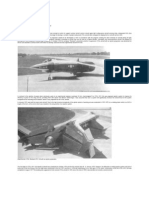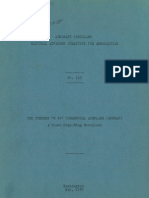0 ratings0% found this document useful (0 votes)
115 viewsBreguet 94O and 941: Initiation of Important STOL Programme
Breguet 94O and 941: Initiation of Important STOL Programme
Uploaded by
dagger21The first flight of the Breguet 940 Integral STOL aircraft took place on May 30, 1958 and lasted 15 minutes, reaching heights of up to 2,300 feet. The Integral uses blown wing technology with four 400 hp turboprop engines on a common transverse wing shaft. This first successful flight marks an important milestone for Breguet in STOL research. Breguet plans to develop the 18-ton Breguet 941 with four General Electric turboprops if the 940 is successful, as the design shows potential for both military assault transport and civilian cargo/passenger use from short, unprepared runways.
Copyright:
© All Rights Reserved
Available Formats
Download as PDF, TXT or read online from Scribd
Breguet 94O and 941: Initiation of Important STOL Programme
Breguet 94O and 941: Initiation of Important STOL Programme
Uploaded by
dagger210 ratings0% found this document useful (0 votes)
115 views1 pageThe first flight of the Breguet 940 Integral STOL aircraft took place on May 30, 1958 and lasted 15 minutes, reaching heights of up to 2,300 feet. The Integral uses blown wing technology with four 400 hp turboprop engines on a common transverse wing shaft. This first successful flight marks an important milestone for Breguet in STOL research. Breguet plans to develop the 18-ton Breguet 941 with four General Electric turboprops if the 940 is successful, as the design shows potential for both military assault transport and civilian cargo/passenger use from short, unprepared runways.
Original Description:
Breguet 940 Test Aircraft
Original Title
1958 - 0714
Copyright
© © All Rights Reserved
Available Formats
PDF, TXT or read online from Scribd
Share this document
Did you find this document useful?
Is this content inappropriate?
The first flight of the Breguet 940 Integral STOL aircraft took place on May 30, 1958 and lasted 15 minutes, reaching heights of up to 2,300 feet. The Integral uses blown wing technology with four 400 hp turboprop engines on a common transverse wing shaft. This first successful flight marks an important milestone for Breguet in STOL research. Breguet plans to develop the 18-ton Breguet 941 with four General Electric turboprops if the 940 is successful, as the design shows potential for both military assault transport and civilian cargo/passenger use from short, unprepared runways.
Copyright:
© All Rights Reserved
Available Formats
Download as PDF, TXT or read online from Scribd
Download as pdf or txt
0 ratings0% found this document useful (0 votes)
115 views1 pageBreguet 94O and 941: Initiation of Important STOL Programme
Breguet 94O and 941: Initiation of Important STOL Programme
Uploaded by
dagger21The first flight of the Breguet 940 Integral STOL aircraft took place on May 30, 1958 and lasted 15 minutes, reaching heights of up to 2,300 feet. The Integral uses blown wing technology with four 400 hp turboprop engines on a common transverse wing shaft. This first successful flight marks an important milestone for Breguet in STOL research. Breguet plans to develop the 18-ton Breguet 941 with four General Electric turboprops if the 940 is successful, as the design shows potential for both military assault transport and civilian cargo/passenger use from short, unprepared runways.
Copyright:
© All Rights Reserved
Available Formats
Download as PDF, TXT or read online from Scribd
Download as pdf or txt
You are on page 1of 1
730
FLIGHT, 30 May 1958
BREGUET 94O AND 941
Initiation of Important STOL Programme
The first flight of the Integral (above
and below) was made by Bernard
Witt, with M. Evrard as flight
observer. The machine was airborne
for 15 min at heights up to 2,300ft,
and the flight was described as
"extremely successful." M. Witt is
seen (left) in the Breguet Taon, in
which he established a 1,000-km
closed-circuit record of 649.7 m.p.h.
A
MILESTONE in the history of one of the world's great
aircraft constructors was the first flight, at 6.30 p.m. on
May 21, of the Breguet 940 Integral STOL research
aircraft. The Integral uses the principle of the "blown wing" and
is powered with four 400 h.p. Turbomeca Turmo II turboprops.
Although purely experimental, it has a loading ramp.
The four three-bladed propellers are driven by a common
transverse shaft in the wing leading-edge, pitch being electrically
controlled and synchronized by shafting from an actuator and
synchronizer located in the centre-section. Generator and
hydraulic pump are mounted near the wing-tips and also driven
by the transverse shaft. Each of the engines, running at 34,500
r.p.m., drives a free turbine at 24,000 r.p.m., this being reduced to
3,545 r.p.m. and fed directly into the cross-shaft. Each propeller
is driven by an extension shaft through a further reduction,
maximum r.p.m. being 1,027. Nos. 1 and 3 propellers turn left-
handed and Nos. 2 and 4 right-handed. All four propellers are
permanently connected to the cross-shaft and run together, while
the engines are connected to the system only by their free turbines.
Failure of one engine therefore only reduces the power available,
and feathering is unnecessary. Breguet report that transmission
friction is so low that finger pressure on one propeller blade
easily turns the whole transmission and propeller system. The
12.4ft-diameter propellers are by Breguet, and the transmission by
Potez.
The makers state that if the Integral comes up to expectations
they will proceed with the 18-ton Type 941, having four General
Electric T58 turboprops. They add, "The prospect of such an
aircraft in the assault transport version interests NATO as well as
the French and American Governments. Civil operators are
interested in the cargo or passenger (40) version. . . . This plane
will be able to operate from 656ft non-prepared fields. . . . To
exploit this principle to the fullest, boundary-layer control devices
will probably be used, for sucking and blowing on the high-lift
flaps and the tail." Under the Piasecki-Breguet agreement the
aircraft would be assembled in the U.S.A. by Piasecki.
You might also like
- J-1999-Control of Jet Engines, SpangDocument17 pagesJ-1999-Control of Jet Engines, SpangMohammadReza AminiNo ratings yet
- AL31-FP Engine & Pneumatic Cylinder Project HAL PDFDocument39 pagesAL31-FP Engine & Pneumatic Cylinder Project HAL PDFGuddu100% (5)
- Beaufort Descriptive Manual RAAF Publication 294 Volume 1, 2nd Edition 1943Document330 pagesBeaufort Descriptive Manual RAAF Publication 294 Volume 1, 2nd Edition 1943alfauro100% (1)
- Propeller Aerodynamics: The History, Aerodynamics & Operation of Aircraft PropellersFrom EverandPropeller Aerodynamics: The History, Aerodynamics & Operation of Aircraft PropellersRating: 4.5 out of 5 stars4.5/5 (3)
- Modern Propulsions For Aerospace-A Review: Journal of Aircraft and Spacecraft TechnologyDocument8 pagesModern Propulsions For Aerospace-A Review: Journal of Aircraft and Spacecraft Technologystudent sriitNo ratings yet
- HelicostatsDocument14 pagesHelicostatsTasko SadikovicNo ratings yet
- Aircraft Power PlantDocument2 pagesAircraft Power PlantKarmen Bin FahadNo ratings yet
- 70652-116619 - Luke Stuyvenberg - Dec 17 2015 1258 PM - Stuyvenberg HelicopterturboshaftsDocument10 pages70652-116619 - Luke Stuyvenberg - Dec 17 2015 1258 PM - Stuyvenberg HelicopterturboshaftsAbdoulrazack NaguibNo ratings yet
- Rockwell XFVDocument5 pagesRockwell XFVdwaynefields100% (1)
- DKE641 ch2Document12 pagesDKE641 ch2imanNo ratings yet
- No 1Document20 pagesNo 1airbusboeing1958No ratings yet
- Jet - Engine Nov 2011Document18 pagesJet - Engine Nov 2011FastBastardNo ratings yet
- Project 1794 Final DevelopmentDocument117 pagesProject 1794 Final DevelopmentRealityviews100% (2)
- 2Document2 pages2Tyron CastroNo ratings yet
- TurbofanDocument14 pagesTurbofanRasyid AtmodigdoNo ratings yet
- PropellerDocument18 pagesPropellersunil100% (1)
- Armament: FlightDocument1 pageArmament: Flightseafire47No ratings yet
- Motor Cohete SEPR 84Document9 pagesMotor Cohete SEPR 84ragnarNo ratings yet
- Sae1302 PDFDocument63 pagesSae1302 PDFKshirsagar Sandeep Popat me16d040No ratings yet
- TurbojetDocument8 pagesTurbojethafezasadNo ratings yet
- TurbojetDocument12 pagesTurbojetnileshko10100% (1)
- Turbofan Engine FullDocument29 pagesTurbofan Engine FullPramodPradhan100% (1)
- The Junkers G38Document22 pagesThe Junkers G38Snautzer100% (2)
- Manual Focke Wulf 190A-8Document0 pagesManual Focke Wulf 190A-8aabdallaNo ratings yet
- PER MicroprojectDocument8 pagesPER MicroprojectHARSHAL SONARNo ratings yet
- Extended Range Operation With Two-Engine Airplanes (ETOPS) : HistoryDocument80 pagesExtended Range Operation With Two-Engine Airplanes (ETOPS) : HistoryGautam KashyapNo ratings yet
- 21.jet EnginesDocument12 pages21.jet EnginesPotluri NagasaitejNo ratings yet
- PROPULSION. Short Introduction To Turboprop and TurbofanDocument15 pagesPROPULSION. Short Introduction To Turboprop and TurbofanHao SuNo ratings yet
- General Electric F110 Turbofan MotorDocument11 pagesGeneral Electric F110 Turbofan MotorlizfireupNo ratings yet
- Concept of Jet Propulsi1111onDocument15 pagesConcept of Jet Propulsi1111onanilthedonNo ratings yet
- Turbofan Research PaperDocument14 pagesTurbofan Research PaperLiam StrandNo ratings yet
- Advanced Trends in Turbomachinery DesignsDocument22 pagesAdvanced Trends in Turbomachinery DesignsKarandeep SinghNo ratings yet
- Turbofan Engine ReportDocument20 pagesTurbofan Engine Reportkashuprakash78% (9)
- TurbopropDocument6 pagesTurbopropBala MuruganNo ratings yet
- ESS23AMDocument5 pagesESS23AMasif adnanNo ratings yet
- TurbofanDocument14 pagesTurbofanShivamPanchariya0% (1)
- The Modern Gas TurbineDocument6 pagesThe Modern Gas TurbinelaurciobanuNo ratings yet
- The D.H. Hornet: Air IntakesDocument1 pageThe D.H. Hornet: Air Intakesseafire47No ratings yet
- ApacheDocument22 pagesApacheAbhimanyu Singh100% (1)
- Mi-38T EngDocument17 pagesMi-38T EngNasr PooyaNo ratings yet
- A ViatorDocument37 pagesA ViatorMontse Gazquez FernandezNo ratings yet
- CL-1 Introduction To VSTOLDocument11 pagesCL-1 Introduction To VSTOLMohit GargNo ratings yet
- Unit-Iii Notes PofDocument33 pagesUnit-Iii Notes PofJoshuaNo ratings yet
- Development of Jet Aircraft: Santos-Dumont 14-BisDocument10 pagesDevelopment of Jet Aircraft: Santos-Dumont 14-BisreganNo ratings yet
- Jet EngineDocument8 pagesJet EngineJustin CebrianNo ratings yet
- 5 Airbreathing Jet Engine PDFDocument103 pages5 Airbreathing Jet Engine PDFMahadi Hanna Mridul100% (2)
- Bdu Air CrashDocument39 pagesBdu Air Crashalex.shawaniNo ratings yet
- Jet Planes and Their ImpactDocument3 pagesJet Planes and Their ImpactyofomoopNo ratings yet
- Đ NG Cơ Máy Bay Chương 1Document42 pagesĐ NG Cơ Máy Bay Chương 1Phạm ThiênNo ratings yet
- GteDocument35 pagesGtejjj1728No ratings yet
- AGTE Theory 1 Chapter 1Document41 pagesAGTE Theory 1 Chapter 1Abush NigussieNo ratings yet
- GasturbDocument4 pagesGasturbE IanJNo ratings yet
- Propulsion 0F Aircraft and Gas TurbinesDocument4 pagesPropulsion 0F Aircraft and Gas Turbinesrobbertmd100% (1)
- ET ReeportDocument19 pagesET ReeportAnuGrahSharmaNo ratings yet
- Jet EngineDocument19 pagesJet EngineAbhishek SharmaNo ratings yet
- LM2500 Gas Turbine EngineDocument4 pagesLM2500 Gas Turbine EngineIulia PipirigeanuNo ratings yet
- Aircraft Propulsion: Presented By: B. BALAJI - 111115019 DIBYAJYOTI NAYAK - 111115023Document50 pagesAircraft Propulsion: Presented By: B. BALAJI - 111115019 DIBYAJYOTI NAYAK - 111115023Suhel SkNo ratings yet
- Air Taxi Business ModelDocument62 pagesAir Taxi Business Modeldagger210% (1)
- Have Nose Iraqi Mig-29 of The Us Air Force: Contributing Author Rob Young, Nasic HistorianDocument1 pageHave Nose Iraqi Mig-29 of The Us Air Force: Contributing Author Rob Young, Nasic Historiandagger21No ratings yet
- Have Doughnut - USAF MiG-21 ExploitationDocument310 pagesHave Doughnut - USAF MiG-21 ExploitationTDRSS100% (2)
- Let's Future in Hands of Creditor: Australia's Air 87 Competition Slips To MarchDocument1 pageLet's Future in Hands of Creditor: Australia's Air 87 Competition Slips To Marchdagger21No ratings yet
- Grumman CorporationDocument135 pagesGrumman Corporationdagger21No ratings yet
- Florida West International Airways (RF) (FWL)Document1 pageFlorida West International Airways (RF) (FWL)dagger21No ratings yet
- Directory: World Airliners: OptionDocument1 pageDirectory: World Airliners: Optiondagger21No ratings yet
- New A340 Runs Into Exit Row: Canada Begins Maritime Helicopter Project To Replace Sikorsky CH-124Document1 pageNew A340 Runs Into Exit Row: Canada Begins Maritime Helicopter Project To Replace Sikorsky CH-124dagger21No ratings yet
- Ayres Set To Complete Let Deal: Chinese Study European Overhaul ProposalsDocument1 pageAyres Set To Complete Let Deal: Chinese Study European Overhaul Proposalsdagger21No ratings yet
- USAF Streamlines Training Bids: Wicat Adds Boeing To Training Device PortfolioDocument1 pageUSAF Streamlines Training Bids: Wicat Adds Boeing To Training Device Portfoliodagger21No ratings yet
- Ayres Lets Czech Republic For Fedex Loadmaster Production: Fairchild Lines Up Envoy 3 For June CertificationDocument1 pageAyres Lets Czech Republic For Fedex Loadmaster Production: Fairchild Lines Up Envoy 3 For June Certificationdagger21No ratings yet
- Florida West International Airways (RF) (FWL)Document1 pageFlorida West International Airways (RF) (FWL)dagger21No ratings yet
- Fedex Express in Talks To Acquire Continental Atrs: Australia Reveals Electromagnetic Pulse WeaponDocument1 pageFedex Express in Talks To Acquire Continental Atrs: Australia Reveals Electromagnetic Pulse Weapondagger21No ratings yet
- 1961 - 0077 BR 945Document1 page1961 - 0077 BR 945dagger21No ratings yet
- Ayres Aircraft LoadmasterDocument1 pageAyres Aircraft Loadmasterdagger21No ratings yet
- Assignment 2 NAMEDocument1 pageAssignment 2 NAMEdagger21No ratings yet
- Student Work BookDocument119 pagesStudent Work Bookdagger21No ratings yet
- Date Pilot Acs N LocationDocument6 pagesDate Pilot Acs N Locationdagger21No ratings yet
- Down Fares, Up Traffic: Air Commerce ... Will The Rotodyne Be Cancelled?Document1 pageDown Fares, Up Traffic: Air Commerce ... Will The Rotodyne Be Cancelled?dagger21No ratings yet
- YogaDocument4 pagesYogaAmbar PurohitNo ratings yet
- Effects of Video GamesDocument10 pagesEffects of Video GamesAli, S. M. FurkanNo ratings yet
- MPRDocument45 pagesMPRKaran Batheja86% (7)
- English 2022 NIOS Class 10Document36 pagesEnglish 2022 NIOS Class 10Priyanka GuptaNo ratings yet
- MK 2102-BAE2020 - Aje - ReDocument2 pagesMK 2102-BAE2020 - Aje - ReAngela ThrisanandaNo ratings yet
- KISI PT Aneka Tambang TBK (ANTM) Steady Gold PricesDocument13 pagesKISI PT Aneka Tambang TBK (ANTM) Steady Gold PricesKacang GorengNo ratings yet
- EGPWS Coverage Area - DOC 060-4267-000Document309 pagesEGPWS Coverage Area - DOC 060-4267-000gasparusNo ratings yet
- Silencer Spark Arrestor CatalogueDocument10 pagesSilencer Spark Arrestor CatalogueBasem TamNo ratings yet
- File 7 English1Document1 pageFile 7 English1Stiven bcNo ratings yet
- EM MultiV5 LGRED OutdoorUnits PDFDocument95 pagesEM MultiV5 LGRED OutdoorUnits PDFenlightened1718No ratings yet
- Watco Standard Logistics ContractDocument5 pagesWatco Standard Logistics ContractLilyRichNo ratings yet
- Quiz QuestionsDocument8 pagesQuiz Questionsmodluka26No ratings yet
- Theoretical Framework Thesis SampleDocument4 pagesTheoretical Framework Thesis Samplekimjohnsonseattle100% (2)
- 414 Hw2 SolutionsDocument3 pages414 Hw2 Solutions05joseNo ratings yet
- Acupuncture: A New Method To Treat Tic Disorders in ChildrenDocument6 pagesAcupuncture: A New Method To Treat Tic Disorders in ChildrenNguyễn Trọng ThiệnNo ratings yet
- Tanzania STG 052013 PDFDocument415 pagesTanzania STG 052013 PDFबनकर परिवाराचा लाडका गोट्या100% (1)
- Adrenergic Receptor Blocking AgentDocument2 pagesAdrenergic Receptor Blocking AgentLegendXNo ratings yet
- Chapter 3 Quiz - Basic Calculation, Plans and DrawingDocument6 pagesChapter 3 Quiz - Basic Calculation, Plans and DrawingRaymart Estavillo100% (1)
- Maag SymetroDocument12 pagesMaag SymetroSarvesh Datt PathakNo ratings yet
- Procedure Configuration & Order Process - OpenEMR Project WikiDocument3 pagesProcedure Configuration & Order Process - OpenEMR Project WikiantanoNo ratings yet
- Monster List 2k19 - )Document18 pagesMonster List 2k19 - )sahilNo ratings yet
- Rabe Model 2005 PDFDocument203 pagesRabe Model 2005 PDFMhd Nuh HudawiNo ratings yet
- Practice in Scanning and SkimmingDocument6 pagesPractice in Scanning and SkimmingZulfa Mahdiatur RNo ratings yet
- Diwat National High School (DNHS) Animal Production (Swine) NC Ii Progress ChartDocument1 pageDiwat National High School (DNHS) Animal Production (Swine) NC Ii Progress ChartKirsten Q. CaminongNo ratings yet
- Trade Size Allocation PDFDocument8 pagesTrade Size Allocation PDFAdam PerezNo ratings yet
- Lab ResultsDocument9 pagesLab ResultsMaveric EnriquezNo ratings yet
- Speech RubricDocument2 pagesSpeech RubriclaizakristelgNo ratings yet
- Ifrs 15Document11 pagesIfrs 15vonronsairo041103No ratings yet
- Ethical Issues in The Relation of Physicians With The Pharmaceutical IndustryDocument35 pagesEthical Issues in The Relation of Physicians With The Pharmaceutical IndustryColeen Joyce NeyraNo ratings yet
- ER Brochure Mobile FriendlyDocument32 pagesER Brochure Mobile FriendlysnzrealtorsNo ratings yet











































































































